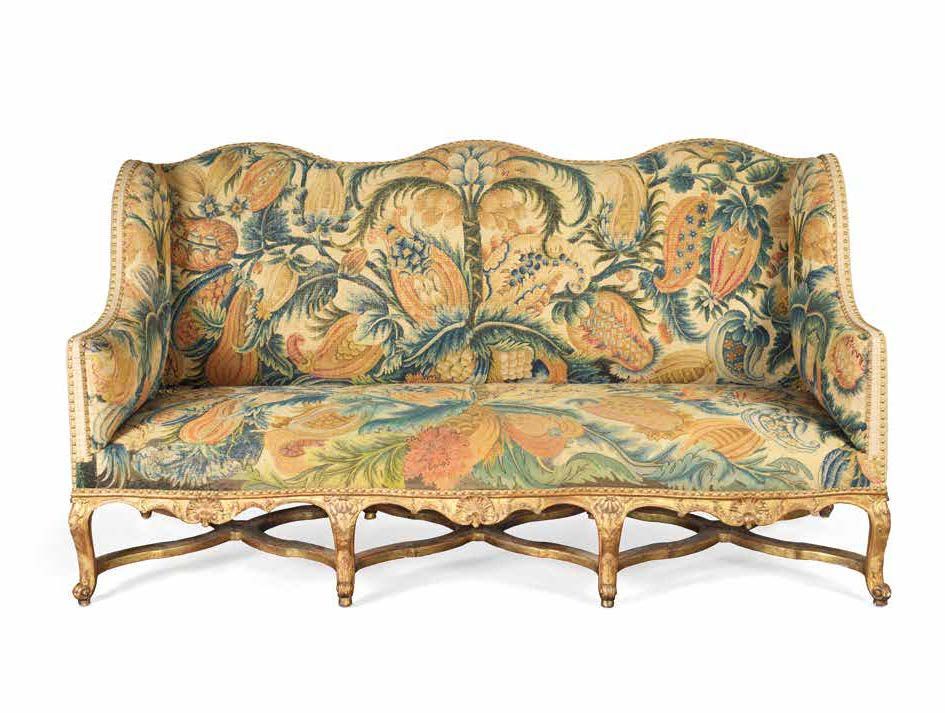Description
LIVING ROOM FURNITURE COVERED WITH TAPESTRIES "À LA GRENADE" from the Château de Sully Regency period Molded, carved and gilded beechwood; wool Reversals of the tapestry Sofa: H. 106 cm, W. 196 cm, D. 90 cm Armchairs: H. 107 cm, W. 70 cm, D. 60 cm PROVENANCE Former collection of the Château de Sully-sur-Loire Sold by Me Baudoin, in Paris, Hôtel Drouot, on February 25, 1942, lot 79, sold for 395,000 Frs, the furniture included a sofa and five armchairs This exceptional salon furniture comes from the Château de Sully-sur-Loire, where it was still in the main salon at the beginning of the last century. Our cheeked sofa and four armchairs à la Reine comfortably furnished the grand salon (fig. 1). The descendants of the first Duke of Sully, who remained owners of the château until 1982, when it was acquired by the Conseil génral du Loiret, dispersed part of the collection in 1942 at a sale in Paris, where our chairs were included in the catalog (fig. 2). This suite presents arrangements that appeared at the end of the reign of Louis XIV (fig. 3). The legs are joined by a sinuous X-shaped brace. The falls and the side rails are decorated with shells and volutes. The wood of the backs is hidden by the upholstery, a rare tapestry in gros point of the same period with polychrome decoration of pomegranates, palms and poppies on a cream background. One must imagine the hangings that accompanied them. The search for harmony in the rich interiors of the 18th century encouraged emulation between the great French royal manufactures. The rooms with walls stretched with tapestries from Aubusson, Beauvais or Gobelins were furnished with seats covered with the same (fig. 4). The great late Roman Baroque art is represented in this beautiful console in carved and gilded wood. The center of the belt is flanked by a mask of a young woman, surrounded by large volutes of acanthus, clasps and flowers. The presence of a mask in the center of the belt is a motif repeated in the art of Roman carpenters of the early 18th century, associated with massive and abundant forms. The powerful uprights take on the appearance of putti carved in the round, holding a shell above their heads. They seem to emerge from a cornucopia richly carved with acanthus, fruits and trimmings, to support the marble. The two legs are connected by a strut centered on a large shell, surrounded by volutes. In the previous century and under the influence of Bernini, the artists of Rome developed this decorative repertoire by introducing human figures in the heart of their composition. Thus, atlantes, nubians or putti, as on our console, will become the main subjects of this type of furniture.
34
LIVING ROOM FURNITURE COVERED WITH TAPESTRIES "À LA GRENADE" from the Château de Sully Regency period Molded, carved and gilded beechwood; wool Reversals of the tapestry Sofa: H. 106 cm, W. 196 cm, D. 90 cm Armchairs: H. 107 cm, W. 70 cm, D. 60 cm PROVENANCE Former collection of the Château de Sully-sur-Loire Sold by Me Baudoin, in Paris, Hôtel Drouot, on February 25, 1942, lot 79, sold for 395,000 Frs, the furniture included a sofa and five armchairs This exceptional salon furniture comes from the Château de Sully-sur-Loire, where it was still in the main salon at the beginning of the last century. Our cheeked sofa and four armchairs à la Reine comfortably furnished the grand salon (fig. 1). The descendants of the first Duke of Sully, who remained owners of the château until 1982, when it was acquired by the Conseil génral du Loiret, dispersed part of the collection in 1942 at a sale in Paris, where our chairs were included in the catalog (fig. 2). This suite presents arrangements that appeared at the end of the reign of Louis XIV (fig. 3). The legs are joined by a sinuous X-shaped brace. The falls and the side rails are decorated with shells and volutes. The wood of the backs is hidden by the upholstery, a rare tapestry in gros point of the same period with polychrome decoration of pomegranates, palms and poppies on a cream background. One must imagine the hangings that accompanied them. The search for harmony in the rich interiors of the 18th century encouraged emulation between the great French royal manufactures. The rooms with walls stretched with tapestries from Aubusson, Beauvais or Gobelins were furnished with seats covered with the same (fig. 4). The great late Roman Baroque art is represented in this beautiful console in carved and gilded wood. The center of the belt is flanked by a mask of a young woman, surrounded by large volutes of acanthus, clasps and flowers. The presence of a mask in the center of the belt is a motif repeated in the art of Roman carpenters of the early 18th century, associated with massive and abundant forms. The powerful uprights take on the appearance of putti carved in the round, holding a shell above their heads. They seem to emerge from a cornucopia richly carved with acanthus, fruits and trimmings, to support the marble. The two legs are connected by a strut centered on a large shell, surrounded by volutes. In the previous century and under the influence of Bernini, the artists of Rome developed this decorative repertoire by introducing human figures in the heart of their composition. Thus, atlantes, nubians or putti, as on our console, will become the main subjects of this type of furniture.
